|

DPAS
REVIEWS
Deep
Purple - 'Kneel & Pray' Live In Montreux '69
The
set starts with the extended swell of Hammer horror-esque Hammond, ebbing
and flowing for nigh on 45 seconds until the familiar lurching intro
of what we now know as Speed King kicks in...
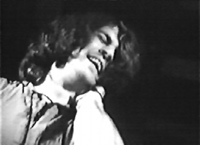 Some
of the lyrical structures are familiar, as is the music (the references
to Miss Molly, Lucille etc are there) but there's no "chorus" as such
lyrically, and the break after the chorus is much more deft, rolling
away with none of the crashing power that later developed to carry the
chorus into the following verses. Gillan screams through much of the
second verse (no lyrics), then the middle section is upon us, "you've
got to kneel down, turn around, tell me what you found" being a familiar
strain to those owners of the Paradiso `69 boots floating around. (check
www.purplemash.demon.co.uk
for details of known vinyl and CD bootleg titles from the era) . Much
of the construction is closer to the BBC studios version, still way
off from the final brutal onslaught of the In Rock version but the ending
is an exercise in controlled power; tight and to the point. Ian Gillan
actually credits the track as Kneel And Pray after the embryonic
song, still developing into the fully-fledged bruiser which the band
are still kicking about thirty years after this was laid down onto copper
oxide. Some
of the lyrical structures are familiar, as is the music (the references
to Miss Molly, Lucille etc are there) but there's no "chorus" as such
lyrically, and the break after the chorus is much more deft, rolling
away with none of the crashing power that later developed to carry the
chorus into the following verses. Gillan screams through much of the
second verse (no lyrics), then the middle section is upon us, "you've
got to kneel down, turn around, tell me what you found" being a familiar
strain to those owners of the Paradiso `69 boots floating around. (check
www.purplemash.demon.co.uk
for details of known vinyl and CD bootleg titles from the era) . Much
of the construction is closer to the BBC studios version, still way
off from the final brutal onslaught of the In Rock version but the ending
is an exercise in controlled power; tight and to the point. Ian Gillan
actually credits the track as Kneel And Pray after the embryonic
song, still developing into the fully-fledged bruiser which the band
are still kicking about thirty years after this was laid down onto copper
oxide.
|
Tracklist:
Kneel And Pray / Wring That Neck / Hush / Child In Time /
Paint It Black / Mandrake Root
/ Kentucky Woman
|
In
terms of sound, I'm immediately thinking of "Space Vol1 & 2" (also
available on Purple Records right now), or any of the Aachen `70 boot
titles, with everything up there (but crisper and cleaner given the
official nature of this recording) and an overloaded vocal which strains
at the speakers in more intense moments. Instrumentally, though, there
are no such issues.
Wring
That Neck was, by this time a well established and lengthy staple
of the Deep Purple set, never perfunctory but certainly way more polished
than the opener. Blackmore and Lord (as ever in those days) spar for
supremacy and in turn vying to outdo each other, flicking the switch
between effortless jazz chords, particularly Ritchie's simple rhythmic
work here, and then disappearing off with stratospheric roaring solos.
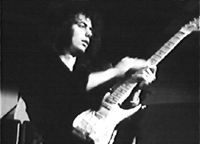 You
can only guess at the excitement at being witness first hand to this,
the recording eerily laying bare the band without the intrusion of an
audience to which those of us who explore the Purple legacy through
the bootleg medium have come to become accustomed. At just under 6 minutes
in the track, everybody backs off and Paicey's shuffle and Roger's throbbing
basswork underpin some nice noodling from Ritchie before the accelerator
(or should that be volume pedal?) is applied again, some truly electrifying
guitar work building to one of the many crescendos of the song. My fingers
hurt just imagining how this sort of stuff can be played by one set
of hands alone. You
can only guess at the excitement at being witness first hand to this,
the recording eerily laying bare the band without the intrusion of an
audience to which those of us who explore the Purple legacy through
the bootleg medium have come to become accustomed. At just under 6 minutes
in the track, everybody backs off and Paicey's shuffle and Roger's throbbing
basswork underpin some nice noodling from Ritchie before the accelerator
(or should that be volume pedal?) is applied again, some truly electrifying
guitar work building to one of the many crescendos of the song. My fingers
hurt just imagining how this sort of stuff can be played by one set
of hands alone.
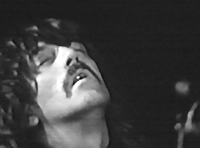 Eventually
though, Blackmore backs off and it's Jon's turn to work, unaccompanied
on one of his classically inspired outings, darting metaphorically off
all over the place while tying together the loose ends with various
musical themes with the occasional assistance of Roger and little Ian,
before the reigns are handed back to the man in black for his solo spot.
It's reminiscent of his work for the band's pre Concerto set, which
had taken place just a couple of weeks or so prior to this set. None
of the nervous picking here though. Free of the pressures of TV cameras,
Ritchie winds it up all the way before the band crash out in a frenetic,
full-on finale to the track. Eventually
though, Blackmore backs off and it's Jon's turn to work, unaccompanied
on one of his classically inspired outings, darting metaphorically off
all over the place while tying together the loose ends with various
musical themes with the occasional assistance of Roger and little Ian,
before the reigns are handed back to the man in black for his solo spot.
It's reminiscent of his work for the band's pre Concerto set, which
had taken place just a couple of weeks or so prior to this set. None
of the nervous picking here though. Free of the pressures of TV cameras,
Ritchie winds it up all the way before the band crash out in a frenetic,
full-on finale to the track.
Next up, some light relief from the musical bombardment as the band
launch into Hush, attacked with some more vigour than their attempt
at the abovementioned Concerto. Jon and Ritchie again spar, as little
Ian tackles a hypnotic drum backing to the instrumental section, drawn
out and again featuring some excellent keyboard work which seems to
go on and on, Ritchie's chopping guitar accompaniment again ranging
from measured picking to almost hacking in intensity, as Jon's lengthy
solo rises to it's intense peak before the song is closed out by the
re-entry of Ian Gillan.
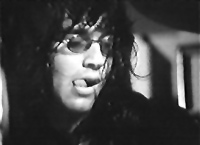 "Let
that man out immediately" cries Gillan in response to something I can't
quite make out from elsewhere on the stage as the band slow things down
for Child In Time, again
sound fresh, crisp and assured. As the song has been played and played
over the years, some of the dynamics and atmosphere on display here
have sadly been lost in favour of a more obvious suckerpunch, but back
in `69 Gillan could still scream and the dynamics were controlled rather
than overwhelmingly elevated by the use of overloaded guitars and sheer
brute force volume. Here we have what could be considered definitive
Deep Purple, displaying on the one hand a measured calm and confidence
towards their music and then that "teetering on the precipice" sensation
as they pound away at the middle section of the song, crackling with
energy until the familiar run of triplets heralds the abrupt termination
and return to near-silence, Jon continuing almost as if in a world of
his own for a few bars after everyone else has stopped, before switching
gear down to begin the final section of the song. "Let
that man out immediately" cries Gillan in response to something I can't
quite make out from elsewhere on the stage as the band slow things down
for Child In Time, again
sound fresh, crisp and assured. As the song has been played and played
over the years, some of the dynamics and atmosphere on display here
have sadly been lost in favour of a more obvious suckerpunch, but back
in `69 Gillan could still scream and the dynamics were controlled rather
than overwhelmingly elevated by the use of overloaded guitars and sheer
brute force volume. Here we have what could be considered definitive
Deep Purple, displaying on the one hand a measured calm and confidence
towards their music and then that "teetering on the precipice" sensation
as they pound away at the middle section of the song, crackling with
energy until the familiar run of triplets heralds the abrupt termination
and return to near-silence, Jon continuing almost as if in a world of
his own for a few bars after everyone else has stopped, before switching
gear down to begin the final section of the song.
Paint It Black starts off with some gusto, I don't know why,
but the sound of this recording lends itself much more to allowing the
ear to concentrate on each of the instruments in turn. The brief nod
in the direction of the Stones original melody is quickly blown away
as Paicey bashes the skins for nigh-on eight minutes before reprising
the riff, Jon carrying the tune while Ritchie abuses the trem with little
or no regard for it's well-being.
 Closing
out the main body of the set is the second lengthy (mainly!) instrumental
Mandrake Root, again similar in feel to many of the known bootlegs
from the `69/'70 period. Once established, the song changed little until
it metamorphosed into the instrumental sections of Space Truckin in
1972 but here, again, there's a freshness to the bobbling bass and drum
work, with parts of Jon's keyboard work nodding a hint of The Mule and
Grabsplatter... or is it just my imagination. This one just keeps going
and going, freeform work held up on an at times imponderably thin and
subtle layer of rhythm work, Ritchie idly picking away in the background
while Jon doodles away with seemingly no desire to stop before taking
the volume (but not energy) level down a few bars, everyone winding
off the volume to take the song into a more deliberated direction, before
pumping up the volume to allow for Mr B. to take centre stage for some
further trem abuse. His use of eastern sounding (as in Egypt, not Cromer)
scales takes things up a further notch. I know the triplet I'm expecting
here, but Ritchie teases and teases, returning time and time again to
inflict the sort of abuse on his poor guitar that leaves my ears not
able to believe the noises generated from the groaning Marshalls without
the guitar having been broken into a thousand pieces. Eventually he
relents and Jon takes over briefly, presumably the guitar having been
kicked about around the floor and now requiring to be returned around
it's owner's neck for the final few seconds of the song and then that's
it, "thank you very much and good night", all over bar the obligatory
curtain call. Closing
out the main body of the set is the second lengthy (mainly!) instrumental
Mandrake Root, again similar in feel to many of the known bootlegs
from the `69/'70 period. Once established, the song changed little until
it metamorphosed into the instrumental sections of Space Truckin in
1972 but here, again, there's a freshness to the bobbling bass and drum
work, with parts of Jon's keyboard work nodding a hint of The Mule and
Grabsplatter... or is it just my imagination. This one just keeps going
and going, freeform work held up on an at times imponderably thin and
subtle layer of rhythm work, Ritchie idly picking away in the background
while Jon doodles away with seemingly no desire to stop before taking
the volume (but not energy) level down a few bars, everyone winding
off the volume to take the song into a more deliberated direction, before
pumping up the volume to allow for Mr B. to take centre stage for some
further trem abuse. His use of eastern sounding (as in Egypt, not Cromer)
scales takes things up a further notch. I know the triplet I'm expecting
here, but Ritchie teases and teases, returning time and time again to
inflict the sort of abuse on his poor guitar that leaves my ears not
able to believe the noises generated from the groaning Marshalls without
the guitar having been broken into a thousand pieces. Eventually he
relents and Jon takes over briefly, presumably the guitar having been
kicked about around the floor and now requiring to be returned around
it's owner's neck for the final few seconds of the song and then that's
it, "thank you very much and good night", all over bar the obligatory
curtain call.
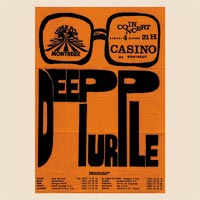 But
what's this, it says Kentucky Woman is the encore. Nah?? Bloody hell,
it really IS Kentucky Woman! Close to the original album version,
the vocals here are particularly overloaded, and instrumentally Jon
is all over his keyboard as everyone else pounds away relentlessly.
Ritchie's solo is an especially fine example of guitar strangulation,
not quite the bizarrely off-kilter affair of the studio take, but sticking
to the spirit. Jon's keyboard solo has, I'm quite sure, been used by
him to introduce Lazy on their more recent tours, where it comes from
I cannot claim to know, but the musical familiarity doesn't last long
as his hands slide ever onward up the keys to give the familiar swell
before we're back into the final verse and chorus. Fun, interesting
and historically important, the first (and probably last) known take
of this song featuring Roger and Ian G. But
what's this, it says Kentucky Woman is the encore. Nah?? Bloody hell,
it really IS Kentucky Woman! Close to the original album version,
the vocals here are particularly overloaded, and instrumentally Jon
is all over his keyboard as everyone else pounds away relentlessly.
Ritchie's solo is an especially fine example of guitar strangulation,
not quite the bizarrely off-kilter affair of the studio take, but sticking
to the spirit. Jon's keyboard solo has, I'm quite sure, been used by
him to introduce Lazy on their more recent tours, where it comes from
I cannot claim to know, but the musical familiarity doesn't last long
as his hands slide ever onward up the keys to give the familiar swell
before we're back into the final verse and chorus. Fun, interesting
and historically important, the first (and probably last) known take
of this song featuring Roger and Ian G.
I know that I welcome every Sonic Zoom release with more superlatives
and unconditional acceptance, but this one is new to all of us. There's
no full set from this era already available, and the inclusion of this
elsewhere unavailable mk2 encore merely makes this an essential set.
No excuses!
review:
Martin Ashberry
Purple Records'
official "Sonic Zoom" series makes available live recordings of
Deep Purple between 1968 and 1976 to the collector. The CDs are
available to everyone, but only via mail-order. The Deep Purple
Appreciation Society is the official outlet through dpas online
and their mail-order catalogue. DPAS members are also eligible
for a discount.
|
Deep
Purple live at the Casino, Montreux, October 4th 1969.
Nobody now recalls why the decision was taken to record
this gig. Most likely,
the group and managers wanted to capture a headlining show to
evaluate a full performance and see how well the new line-up
was working in a live context.
A
quarter inch reel was plugged into the mixing desk, and was
fed directly from the live sound and mixed on the fly. This
is the tape used for this release. No further mixing was possible
- and this also explains the fluctuating levels which occur
during the opening numbers.
Sound
restoration was carried out to boost frequencies and reduce
hiss, but what you get here is near enough exactly what the
sound engineer heard back in 1969. This set was discovered in
1999 when Deep Purple's sound archives were moved for safer
storage. Unlike previous releases on the Sonic Zoom label, it
has remained entirely outside the bootleggers' domain in over
thirty years.
|
|

 Some
of the lyrical structures are familiar, as is the music (the references
to Miss Molly, Lucille etc are there) but there's no "chorus" as such
lyrically, and the break after the chorus is much more deft, rolling
away with none of the crashing power that later developed to carry the
chorus into the following verses. Gillan screams through much of the
second verse (no lyrics), then the middle section is upon us, "you've
got to kneel down, turn around, tell me what you found" being a familiar
strain to those owners of the Paradiso `69 boots floating around. (check
Some
of the lyrical structures are familiar, as is the music (the references
to Miss Molly, Lucille etc are there) but there's no "chorus" as such
lyrically, and the break after the chorus is much more deft, rolling
away with none of the crashing power that later developed to carry the
chorus into the following verses. Gillan screams through much of the
second verse (no lyrics), then the middle section is upon us, "you've
got to kneel down, turn around, tell me what you found" being a familiar
strain to those owners of the Paradiso `69 boots floating around. (check
 You
can only guess at the excitement at being witness first hand to this,
the recording eerily laying bare the band without the intrusion of an
audience to which those of us who explore the Purple legacy through
the bootleg medium have come to become accustomed. At just under 6 minutes
in the track, everybody backs off and Paicey's shuffle and Roger's throbbing
basswork underpin some nice noodling from Ritchie before the accelerator
(or should that be volume pedal?) is applied again, some truly electrifying
guitar work building to one of the many crescendos of the song. My fingers
hurt just imagining how this sort of stuff can be played by one set
of hands alone.
You
can only guess at the excitement at being witness first hand to this,
the recording eerily laying bare the band without the intrusion of an
audience to which those of us who explore the Purple legacy through
the bootleg medium have come to become accustomed. At just under 6 minutes
in the track, everybody backs off and Paicey's shuffle and Roger's throbbing
basswork underpin some nice noodling from Ritchie before the accelerator
(or should that be volume pedal?) is applied again, some truly electrifying
guitar work building to one of the many crescendos of the song. My fingers
hurt just imagining how this sort of stuff can be played by one set
of hands alone. Eventually
though, Blackmore backs off and it's Jon's turn to work, unaccompanied
on one of his classically inspired outings, darting metaphorically off
all over the place while tying together the loose ends with various
musical themes with the occasional assistance of Roger and little Ian,
before the reigns are handed back to the man in black for his solo spot.
It's reminiscent of his work for the band's pre Concerto set, which
had taken place just a couple of weeks or so prior to this set. None
of the nervous picking here though. Free of the pressures of TV cameras,
Ritchie winds it up all the way before the band crash out in a frenetic,
full-on finale to the track.
Eventually
though, Blackmore backs off and it's Jon's turn to work, unaccompanied
on one of his classically inspired outings, darting metaphorically off
all over the place while tying together the loose ends with various
musical themes with the occasional assistance of Roger and little Ian,
before the reigns are handed back to the man in black for his solo spot.
It's reminiscent of his work for the band's pre Concerto set, which
had taken place just a couple of weeks or so prior to this set. None
of the nervous picking here though. Free of the pressures of TV cameras,
Ritchie winds it up all the way before the band crash out in a frenetic,
full-on finale to the track. "Let
that man out immediately" cries Gillan in response to something I can't
quite make out from elsewhere on the stage as the band slow things down
for
"Let
that man out immediately" cries Gillan in response to something I can't
quite make out from elsewhere on the stage as the band slow things down
for  Closing
out the main body of the set is the second lengthy (mainly!) instrumental
Mandrake Root, again similar in feel to many of the known bootlegs
from the `69/'70 period. Once established, the song changed little until
it metamorphosed into the instrumental sections of Space Truckin in
1972 but here, again, there's a freshness to the bobbling bass and drum
work, with parts of Jon's keyboard work nodding a hint of The Mule and
Grabsplatter... or is it just my imagination. This one just keeps going
and going, freeform work held up on an at times imponderably thin and
subtle layer of rhythm work, Ritchie idly picking away in the background
while Jon doodles away with seemingly no desire to stop before taking
the volume (but not energy) level down a few bars, everyone winding
off the volume to take the song into a more deliberated direction, before
pumping up the volume to allow for Mr B. to take centre stage for some
further trem abuse. His use of eastern sounding (as in Egypt, not Cromer)
scales takes things up a further notch. I know the triplet I'm expecting
here, but Ritchie teases and teases, returning time and time again to
inflict the sort of abuse on his poor guitar that leaves my ears not
able to believe the noises generated from the groaning Marshalls without
the guitar having been broken into a thousand pieces. Eventually he
relents and Jon takes over briefly, presumably the guitar having been
kicked about around the floor and now requiring to be returned around
it's owner's neck for the final few seconds of the song and then that's
it, "thank you very much and good night", all over bar the obligatory
curtain call.
Closing
out the main body of the set is the second lengthy (mainly!) instrumental
Mandrake Root, again similar in feel to many of the known bootlegs
from the `69/'70 period. Once established, the song changed little until
it metamorphosed into the instrumental sections of Space Truckin in
1972 but here, again, there's a freshness to the bobbling bass and drum
work, with parts of Jon's keyboard work nodding a hint of The Mule and
Grabsplatter... or is it just my imagination. This one just keeps going
and going, freeform work held up on an at times imponderably thin and
subtle layer of rhythm work, Ritchie idly picking away in the background
while Jon doodles away with seemingly no desire to stop before taking
the volume (but not energy) level down a few bars, everyone winding
off the volume to take the song into a more deliberated direction, before
pumping up the volume to allow for Mr B. to take centre stage for some
further trem abuse. His use of eastern sounding (as in Egypt, not Cromer)
scales takes things up a further notch. I know the triplet I'm expecting
here, but Ritchie teases and teases, returning time and time again to
inflict the sort of abuse on his poor guitar that leaves my ears not
able to believe the noises generated from the groaning Marshalls without
the guitar having been broken into a thousand pieces. Eventually he
relents and Jon takes over briefly, presumably the guitar having been
kicked about around the floor and now requiring to be returned around
it's owner's neck for the final few seconds of the song and then that's
it, "thank you very much and good night", all over bar the obligatory
curtain call. But
what's this, it says Kentucky Woman is the encore. Nah?? Bloody hell,
it really IS Kentucky Woman! Close to the original album version,
the vocals here are particularly overloaded, and instrumentally Jon
is all over his keyboard as everyone else pounds away relentlessly.
Ritchie's solo is an especially fine example of guitar strangulation,
not quite the bizarrely off-kilter affair of the studio take, but sticking
to the spirit. Jon's keyboard solo has, I'm quite sure, been used by
him to introduce Lazy on their more recent tours, where it comes from
I cannot claim to know, but the musical familiarity doesn't last long
as his hands slide ever onward up the keys to give the familiar swell
before we're back into the final verse and chorus. Fun, interesting
and historically important, the first (and probably last) known take
of this song featuring Roger and Ian G.
But
what's this, it says Kentucky Woman is the encore. Nah?? Bloody hell,
it really IS Kentucky Woman! Close to the original album version,
the vocals here are particularly overloaded, and instrumentally Jon
is all over his keyboard as everyone else pounds away relentlessly.
Ritchie's solo is an especially fine example of guitar strangulation,
not quite the bizarrely off-kilter affair of the studio take, but sticking
to the spirit. Jon's keyboard solo has, I'm quite sure, been used by
him to introduce Lazy on their more recent tours, where it comes from
I cannot claim to know, but the musical familiarity doesn't last long
as his hands slide ever onward up the keys to give the familiar swell
before we're back into the final verse and chorus. Fun, interesting
and historically important, the first (and probably last) known take
of this song featuring Roger and Ian G.